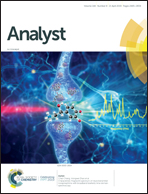Construction of an ultrasensitive electrochemiluminescent aptasensor for ractopamine detection†
Abstract
In this study, an ultrasensitive electrochemiluminescence (ECL) aptasensor based on Ru(bpy)32+-doped silica nanoparticles (Ru@SiO2 NPs) coupled with gold nanoparticles (Au NPs) was developed for the determination of ractopamine (Rac). TPrA is used as the coreactant, the Ru@SiO2 NPs serve as the ECL luminophores, and the Au NPs work as a catalyzer in the redox reaction as well as the carrier that immobilizes the aptamer. Meanwhile, the complete incorporation of the Ru@SiO2 NPs and Au NPs increases the localized surface plasmon resonance (LSPR) probability, thus promoting ECL emission. The ractopamine (Rac) target molecules are specifically captured on the electrode surface by aptamer recognition. The ECL signal is quenched by energy transfer from the luminophore to benzoquinone compounds, which are oxidative products of Rac from the electrochemical scanning process. The proposed ECL aptasensor exhibits ultrahigh sensitivity and excellent selectivity for Rac detection. The linear response ranged over Rac concentrations from 1.5 × 10−12 M to 1.5 × 10−8 M with a detection limit of 4.1 × 10−14 M (S/N = 3). The detection recovery of Rac in real meat samples confirmed the satisfactory performance of the method. This study describes a versatile ECL aptasensor based on the combined functions of luminous nanospheres and Au NPs, indicating its potential application for the ultrasensitive analysis of targets in diverse systems.



 Please wait while we load your content...
Please wait while we load your content...